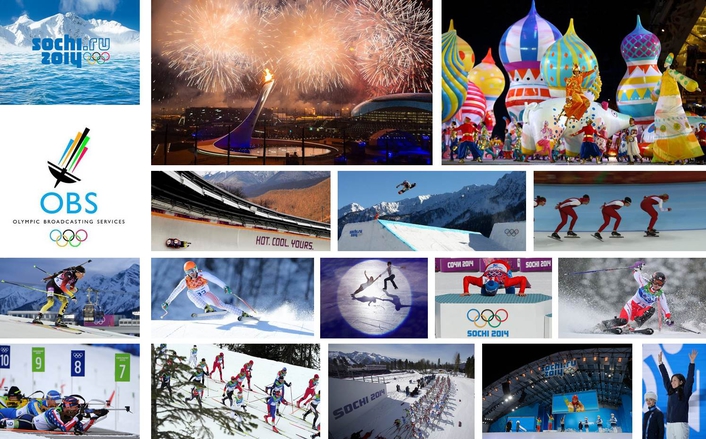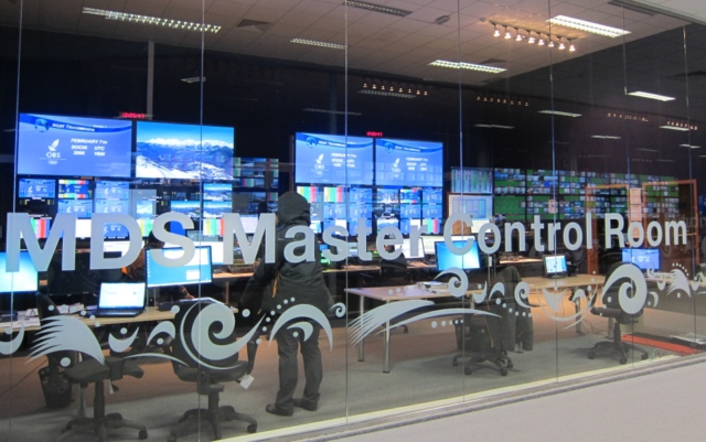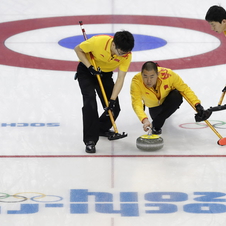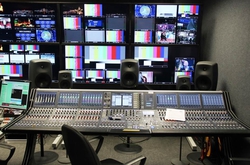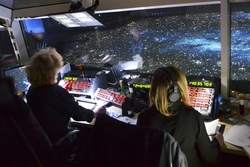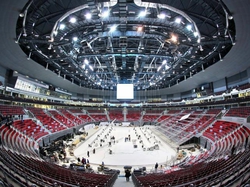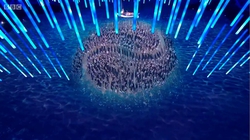Review Sochi 2014: Broadcasting the Magic of the Games Across the World
posted:
The IOC funds the operations of OBS at the Games, removing the financial burden from the organizers, while ensuring that high quality Olympic broadcast programming is delivered to rights-holding broadcasters (RHBs) to air over various media platforms throughout the world.
Providing a service on behalf of the International Olympic Committee (IOC)
During the Sochi 2014 Olympic Winter Games, OBS has used more than 450 cameras to produce over 1,300 hours of live sport, ceremonies and Olympic News Channel (ONC) coverage. This coverage was distributed by more than 80 RHBs across the world. The Sochi Games have reached an unprecedented 200 countries, more than any other Olympic Winter Games.
advertisment
To implement and manage this vital broadcasting operation, the OBS team increased from 150 full-time employees to a workforce of approximately 3,200 by the start of the Games. Assisting the Organizing Committee throughout the planning phase for Sochi, OBS has also been working in close collaboration with RHBs at competition venues, the International Broadcast Centre (IBC) and the Mountain Broadcast Centre (MBC). These Games saw more than 7,500 broadcast professionals working across all of these areas.
Located in the Main Media Centre (MMC) in the Coastal Cluster, the IBC was the main hub for television coverage of the Games. Encompassing more than 40,000 square meters and operating 24 hours a day, the IBC has welcomed more than 55 rights-holding broadcast organizations with a presence in the facility (including sub-licensees). The MBC was a 9,000 square meters facility situated in the Mountain Cluster and was offering rights-holders the opportunity to use their post-production facilities within a short distance of all skiing and sliding competition venues.
advertisment
Among the highlights this year were the delivery of 49 Full HD feeds, including all the competitive action, ceremonies, media conferences, and beauty shots. In addition, all TV audio was produced in 5.1 surround sound with the exception of the ONC.
The Multichannel Distribution Service and the Multi Clips Feed
The News Channel itself continued to be an important offering by OBS, giving RHBs that do not have the financial resources to produce their own programming a ready-to-serve 24/7 program feed with highlights, interviews, and feature reports. Teaming that with the OBS Multichannel Distribution Service (MDS), which offered seven ready-to-air channels of live content via satellite, made it easier than ever for RHBs from small nations to deliver a big-time look. A new service for the RHBs was the Multi Clips Feed (MCF), which distributed supplementary clips from the alpine events, giving RHBs access to unseen camera angles, primarily from high-speed cameras. During competition additional clips of each athlete from the specialty cameras were recorded during the run so that when the skier finished the run a string of additional angles were available for post-production needs.
advertisment
The Olympic Video Player
Also new this year was the Olympic Video Player (OVP) that delivered content to mobile devices. The launch of the OVP was envisioned for 2016 at the Rio Summer Olympics. However 10 months ago, OBS got so excited that it decided to try it in Sochi as the Games are smaller and it would be a good testing ground. The OVP has allowed the IOC to broadcast the Winter Games in territories that have never experienced the Winter Olympics. The whole of Sub-Saharan Africa, the Caribbean, and the Arab world are all experienced the OVP making the Sochi games the first universal Winter Olympics.
advertisment
Sub-Saharan Africa, for example, had issues with the distribution of the London Summer Games because of the financial conditions and so on. But now these countries are leapfrogging by going direct to mobile devices and never may have the Olympics by traditional broadcasting. The OVP is a way to penetrate and develop familiarity with the Olympics in those areas.
Another example is YLE. There are smartphones and tablets all over Finland. YLE created two versions of the OVP, one in Finnish and one in Swedish. Already in the first week the app was downloaded more than 300,000 times and had 28 million opens and on last Monday the total viewing was 1.3 million hours. And even students in class are rumored to be checking in on the Olympics between classes, giving a new –technology spin to the old days of sneaking a transistor radio into class.
The digital revolution we have been talking about for 10 or 15 years is happening, and it is becoming almost as important as traditional broadcasting.
advertisment
The flexibility of digital Platforms
For the Winter Games in Sochi all the RHBs had 11,000 accredited employees on site and for the Summer Games in Rio the number will double. These numbers need to be reduced because they are unsustainable for the cities that host the games. One of OBS’ key strategies is to enable broadcasters to do more with less so they can bring fewer resources to the games and the MDS is part of this strategy. OBS started the MDS at the Winter Olympics in Vancouver by delivering the service to five RHBs and four years later at Sochi 70 RHBs are making best use of the service. It is the primary distribution platform for Olympic images in the majority of territories in the world, with the exception of big broadcasters like NBC, the Japanese, and the Germans and so on. But those who do take it share the costs of the platform, save money on telecoms, and have vastly more content as we put practically everything on the MDS. And they have a product that is ready-made to be put on any platform because it has English, Spanish, and Arab commentary.
advertisment
The MDS feed also includes a live stream of data that helps RHBs do a lot of work back home. Other than the physical proximity to the event and to the athletes, these tools more or less enable broadcasters to do back home what they do at the IBC. Redundant 10GB fiber pipes are a reality already today allowing editors on location to dip into their MAM at the home base, however also the alternative route is possible: accessing the content in the IBC MAM from the RHBs home base. Services like MDS will allow more staff to work from home. This will change the tone of the IBC to one where the RHBs are primarily run ENG operations.
Specific production enhancements
Alpine and Sledding
Ghost-image comparison was provided on skiing and the sliding events (bobsled, skeleton, and luge), with images of one athlete laid over another to analyze technique and relative positions. And the sledding track featured a virtual sled path on the track during replays to clearly see the course chosen by the race team and compare it with other competitors’.
Curling
In curling, a “stone trajectory,” a virtual line that highlighted the stone’s path down the sheet was available. Also throw analysis, a virtual overhead shot used in conjunction with a replay sequence to show the stone path, was offered.
advertisment
Freestyle/snowboard
The freestyle and snowboard events offered jump analysis, half-pipe jump height, and virtual flags of athletes in the slalom events to show how they finished crossing the line.
Ski jumping
A virtual line displayed the current best jump across the landing zone, and live wind information measured 10 points on the hill and displayed it over live pictures.
Speed skating
As in the freestyle and snowboard events, there were virtual flags at the finish line. Longer races featured a current-best line, indicating the pace set by the fastest skater so that viewers saw the difference between the leader and the others.
advertisment
OBS was using drone cameras for the first time
Drone cameras were used at the Extreme Park. Snowboard and Freestyle Skiing competitions are still grass-roots sports that come from smaller communities. With drone cameras OBS used the opportunity to bring the Olympic standard of coverage to these competitions but without killing the freshness of these sports themselves. OBS will continue to explore them further: they have to be stabilized to match safety regulations; however there are secondary uses like making more interesting introductions to a competition or presenting the field of play in more novel ways.
And looking ahead, Rio is a city that is ideal for those kinds of things, because drones are in the interim space that is between cable cams and helicopters and they really do give a different perspective.
Axon's Signal Processing Equipment at the Heart of Sochi Broadcast
Russian broadcast systems company, ANO Sports Broadcasting has 12 3Gb/s capable OB trucks and 12 support trucks in use on site in Sochi. AXON modular signal processing product line Synapse will be used in a broad range of applications within the OB trucks, including the up, down and cross conversion of 3G signals. AXON modules will support the distribution of video and audio signals throughout the OB truck as well as the embedding and de-embedding of audio signals. Also, AXON miniaturized technology will control the synchronizing, legalizing and keying operations within the fleet. Finally, AXON’s SynView will form the standard multiviewing platform on the trucks.
Read more ...
ORF in Sochi with Support from sonoVTS
sonoVTS Broadcast from Munich provides the entire broadcast and production technology for the Austrian public broadcaster ORF at the 2014 Olympic Winter Games in Sochi: In the Mountain Broadcast Center (MBC) and in the associated television studio which is located about two kilometers away at the “Haus Austria Tyrol”. Here ORF welcomes national and international athletes as well as celebrities. At the MBC the new Harris IP3 router is at the center of the installation featureing a matrix of 288 inputs and 224 outputs. In addition, seven Harris HVSX Pro 32x6 multi-viewers are integrated directly into the router.
Read more ...
Dutch Winter Olympics Coverage Delivered by Universal Videohub
Also at the Sochi Olympics The Netherlands continues to dominate the speed-skating events, and it has been the responsibility of NOS (Nederlandse Omroep Stichting) to make sure all the viewers at home see all the action. In addition to Olympic technology partner Broadcast Rental also Dutchview and United were on site with OBVan facilities to support NOS. NOS deployed the Blackmagic Universal Videohub 288 for signal routing and distribution during its coverage of the Olympic Winter Games. Built by live production specialist Broadcast Rental, the Sochi facility handles more than 60 live signals from across the Games.
Read more ...
Presteigne Broadcast Hire Supports Nippon TV in Sochi
Leading broadcast rental specialist, Presteigne Broadcast Hire has supported broadcasters from around the world as they send coverage back from the current sporting events in Sochi, Russia. These include Japan’s Nippon Television Network (NTV). The broadcaster has rented a number of XDCam decks for recording, editing and ingest. NTV also has an on-site studio, for which Presteigne Broadcast Hire has provided two complete camera chains, together with a studio pedestal. “As Olympic coverage is not an everyday event, we need to supplement our own equipment with rented kit,” said Yujin Suzuki, technical director of NTV. “We have to balance our needs on site with our production plans back in Japan.
Read more ...
Avid to Help Power ‘Everywhere, Anytime’ TV Coverage for ARD & ZDF
ZDF and ARD are sharing facilities to benefit from greater operational synergies. They required a fast, efficient and robust workflow to cater to a wide range of content and distribution demands – from on-the-fly editing, graphics creation and processing to production, management and distribution of content. Together, the Avid and third party integrated workflow will enable faster and more effective collaboration among all members of the production team across a complex, multi-location environment.
Read more ...
ARD and ZDF Utilize Fairlight Audio Post Production Systems
German public broadcasters ARD and ZDF have chosen Fairlight audio post production systems for their coverage of the 2014 Winter Olympic Games in Sochi, Russia. Both broadcasters are offering their viewers extensive coverage of the games in HD from the International Broadcast Centre and the Mountain Broadcast Centre, using ARD and ZDF’s mobile production unit.
Read more ...
NBC Olympics: Two Locations – One Production System
The Olympic Games in Sochi provide an example of the growth of “at home” efforts: A centralized production team like Olympic Broadcasting Services (OBS) does much of the camera and event production work, allowing the Rights Holding Broadcasters (RHBs) to concentrate on editing and building story packages. And more and more broadcasters even reduce their on-location staff by increasing the staff back at their home base, making best use of the data-pipelines which now are available from any international sports event location. One example is NBC Olympics. Already at the 2008 Beijing Games, NBC Olympics has used the large fiber and data pipes to do much more than just backhaul content. The goal has been to give production personnel, no matter where they are located, access to the content they need when they need it and with true autonomy and all located on one media asset management system (MAM). This year, NBC has accomplished that goal: Not only are the two main production centers in Sochi and Stamford (the headquarter of NBC Sports in Connecticut) connected, but all the venue production teams in and around Sochi are as well.
Read more ...
NBC Uses Merging's Ovation for Sochi Olympics
Ovation has been gaining fans in the broadcast community in North America for the last two years. An early adopter was NBCSN at their Sports Center in Stamford, Connecticut. The initial order for four Ovation systems and four Horus units proved the advantages of managing the playout requirements in this way. The equipment list for Sochi for NBC Olympics included three more Ovations and another three Horus. The full suite of digital I/O and RAVENNA remote control of the routing and configuration of Horus allows for easy set up and high quality output.
Read more ...
NBC Olympics’ Production of the 2014 Olympic Winter Games: Live and On-Demand Streaming
Microsoft Corp. has been selected to be the cloud encoding and hosting platform provider for NBC Olympics, a division of the NBC Sports Group, during its production of the 2014 Olympic Winter Games in Sochi, Russia, Feb. 6–23. As a result, viewers will be able to watch Winter Olympics programming via more than 50 live high-definition streams and on demand. The announcement was made today by Richard Cordella, senior vice president and general manager, Digital Media, NBC Sports Group, and Scott Guthrie, acting lead of Microsoft’s Cloud and Enterprise Group.
Read more ...
XD Motion Drone at the Rosa Khutor Extreme Park in Sochi
A dedicated remotly piloted aircraft (RPA Drone) was developed by XD motion to cover the Slopestyle snowboarding and Slopestyle skiing events at the Rosa Khutor Exteme Park during the 2014 Winter Olympics in Sochi. The RPA Drone carries an HD camera with RF link. XD motion had to build a drone to fly long enough to follow the runs of the competitors from start to finish. Finally XD motion achieved a flying time of 16 minutes before the batteries need to be changed.
Read more ...
Riedel to Provide Massive Communications and Signal Distribution Network at Winter Games
Riedel Communications, a leading provider of real-time video, audio, data, and communications networks, announced that the company’s MediorNet fiber-based network is supporting the transport of HD video and audio signals, data, and Riedel Artist intercom signals throughout the 2014 Winter Games in Sochi, Russia. A Riedel Mass Cast deployment including 14 transmitters and thousands of receivers and earpieces provided support during the opening ceremonies and will support performances during closing ceremonies.
Read more ...
CNTV and Sport TV Choose NeuLion to Power Live Streaming of the 2014 Olympics
NeuLion, a leading Internet video technology provider for delivering live and on-demand content to any Internet-enabled device, today announced its TV Everywhere Platform is being used to power live Olympic streaming experiences in China and Portugal to a vast fan base. China's consumer market, forecasted to become the second largest in the world by 2015, continues to grow at a rapid rate. Both Chinese and foreign companies are exploring new ways to keep up as the market evolves. CNTV and NeuLion have continued to stay at the forefront of the expanding Chinese marketplace with their premium digital service, CNTV 5+ VIP. The newest addition to CNTV 5+ VIP is the action packed coverage of the 2014 Winter Olympics in Sochi including exclusive coverage of hockey games as well as all Team China games throughout the Olympics.
Read more ...
IMT Provides Gold-Medal Support for Russian Broadcast Coverage
As people from around the world are gathered in Sochi, Russia, for the Winter Games and Paralympic Games in March, Integrated Microwave Technologies, LLC (IMT), a Business Unit within the Vitec Group’s Videocom Division, and a leader in advanced digital microwave systems serving the Broadcast and Sports & Entertainment markets, is supporting various Russian broadcast entities covering the events with more than 30 Nucomm CamPac2 wireless camera systems (CP2). The system comprises the CamPac2 camera-mounted transmitter and Newscaster DR2 diversity receiver, Sony RPS (Remote Paint System) camera control and digital voice intercom package. The wireless system is one of the most reliable go-to links on the market, delivering consistent, solid coverage.
Read more ...
Panorama Goes for Gold with Orad at the Sochi 2014 Olympic Games
Panorama, Russia’s largest facility company has chosen Orad enterprise graphic and sports solutions to cover the Sochi 2014 Winter Olympics. The graphics and live analysis production workflow features Orad’s MVP Emmy Award Winning sports enhancement solution and PlayMaker slow motion video sports server. Panorama are using Orad's MVP and PlayMaker primarily for their coverage of hockey, figure skating, bobsleigh, and curling. MVP is used in hockey, for example, to analyze the games' strategy, whereas in figure skating it is used to count how many rotations the skater spins/jumps. In curling, MVP provides viewers with a bird's eye view of the match for a unique perspective. The bobsleigh event will be enhanced with MVP's difference maker feature, enabling viewers to easily compare the technique and movement of different races by presenting them together as if the two events happened simultaneously.
Read more ...
NTV+ Picks Orad Graphics for Their Sochi Winter Olympics Coverage
NTV+, Russia's digital satellite broadcaster, has chosen Orad to cover the 2014 Sochi Winter Olympic Games. NTV+, the host broadcasters for the Sochi Olympics who have domestic broadcasting rights for the entire event, will be using multiple Orad graphic solutions to facilitate and simplify their production workflow. Olympic broadcasts traditionally require complex productions because of the many simultaneous events. With Orad’s TD Control and graphic solutions, NTV+’s high paced production will run smoothly and efficiently. NTV+ will be able to easily control their Olympic productions by handling multiple live video boxes and graphics from the different events from a single user interface, ensuring synchronization between operators and devices.
Read more ...
SALZBRENNER STAGETEC MEDIAGROUP technology in Sochi
"As in 2012 our technology will be supporting the sound reinforcement and especially the TV broadcasting of this major international event, as on many previous occasions", explains Stephan Salzbrenner, one of the Managing Directors of the SALZBRENNER STAGETEC MEDIAGROUP. "The demand for high-quality mixing equipment and reliable audio networks is so high that we have sent a number of additional components to Sochi to extend the existing set-up temporarily." The list of installations ranges from several of the newly constructed stadiums to the outside broadcast vehicles of participating television stations to major installations for Swiss broadcaster SRG SSR.
Read more ...
Clear-Com at the Olympic Winter Games in Sochi
Clear-Com intercom systems are installed as permanent systems at three Olympic sporting venues at the Sochi mountain cluster and the Sochi coastal cluster. The systems will be used for production communications during the 2014 Sochi Games. After the Games, the systems will stay at the venues for use at future sporting and/or concert events.
Read more ...
Major Project for ChainMaster at the Olympics in Sochi
From 7 to 23 February, the global elite of winter sports will be gathering in the Russian town of Sochi for the XXIIth Winter Olympics, in the hunt for gold, silver and bronze medals. In all, since the games were awarded to Sochi, eleven competition venues have been created in and around the Black Sea resort. In equipping several of the venues in the Olympic Park, the organizers have relied inter alia on the know-how of ChainMaster of Eilenburg; numerous products from the range of the manufacturer of chain hoists and lifting gear are being employed at the Sochi games. ChainMaster has been active in Russia and the neighbouring states since 1998, and in 2004 opened ChainMaster Consulting Office Russia.
Read more ...
KSC Systems in Sochi
The central demand to have the required space for the complete equipment of the GOP switching center with a few racks only, the conditions for the whole system were set at an early stage. In two workshops, the SRG BUS (Business Unit Sports) project group and the BFE KSC team analyzed the workflows to be mapped in the mobile controller system. In addition to the German-speaking Swiss television SRF also RTS (French-speaking) and RSI (Italian speaking) have been fully supplied by the KSC system of the switching center which is designed for a highly available 24/7 operation. All broadcast devices in the switching center can be controlled manually on both the interactive KSC Circuit surfaces or the operating units. The complete label management for all control panels, KVM and multiviewer is the responsibility of the KSC Controller system. Controlled devices: Harris Router incl. HView multiviewer, Stagetec Nexus, Ihse KVM, Lynx PVD, Snell IQ, etc.
Read more ...
Immersive Forest of Light for Closing Ceremony of Sochi Winter Games
The closing ceremony of the 2014 Winter Olympics wrapped up the most expensive games yet with an exquisite cocktail of Russian music, ballet, art, design and literature - plus a witty and inspired sprinkling of self-deprecation. Much of the action took place amongst a dynamic forest of light, which was created and built by set and stage designer, TAIT Technologies, and programmed by creative UK collective, Immersive. Throughout, the 'Forest of Light' provided the stage architecture that gave scale and perspective for much of the action that unfolded on the huge Fisht Stadium floor. It also provided the perfect TV-picture framing vehicle for the stunning aerial and stadium TV pictures, broadcast worldwide on 23rd February 2014. The impressive Olympics Closing Ceremony design was by Danielle Finzi Pasca. The Forest of Light comprised a custom LED product, designed and built by TAIT Technologies, which was flown from a complex flying system rigged above the field of play.
Read more ...
Dejero Products and Services at the Sochi Winter Games
Dejero customers, including some of the world's top broadcasters and official Games broadcast rights-holders, will use Dejero's award-winning LIVE+ 20/20 Transmitters as well as the LIVE+ Mobile App installed on their smartphones and tablets to transmit live coverage, as well as to store and forward video for later broadcast. Both solutions enable field news reporters to encode and transmit HD or SD video directly over 4G, 3G, Wi-Fi, or Ethernet connections from locations that are impractical for traditional ENG vehicles to access. In addition, the networks' master control personnel will use the cloud-based Dejero LIVE+ Portal to manage and control transmitters, monitor transmission health, and manage the distribution of content on-air and online.
Read more ...
Auditoria Specifies Optocore Network for Sochi Opening/Closing Ceremonies
Within the newly constructed 42,500 capacity Fisht Olympic Stadium in the developing Russian city of Sochi, the XXII Olympic Winter Games drew to an end with the spectacular Closing ceremony. Just as he had done at the Opening extravaganza 16 days earlier, Audio Director Scott Willsallen (of Auditoria) designed the technological infrastructure, placing all the transmission on a 24-node Optocore dual redundant ring and working with two different creative teams to fulfil different objectives.
The formal operatic and cultural Opening Ceremony display, creatively designed by Konstantin Ernst and directed by Andrei Boltenko, made way for the more party atmosphere of the Closing Ceremony, directed by Italian Daniele Finzi Pasca. Featuring nearly 800 performers and representing hundreds of years of Russian history, it was an exacting task. Italy had played a key role this year, as aside from Finzi Pasca, it was L’Aquila-based concert touring specialists Agora who responded successfully to the tender prepared by Willsallen. To design the routing topography, including separate networks for broadcast and live, they purchased large quantities of energy efficient Optocore ‘R’ Series AES-EBU and MADI interfaces from Italian distributors, Audiosales, to add to existing inventory.
Read more ...
Fairlight Delivers Audio of Opening and Closing Ceremonies at Sochi 2014
With a global audience of billions of people from over 200 countries, it was Fairlight technology that delivered the audio for the spectacular opening and closing ceremonies at the Fisht Stadium of the 2014 Winter Olympics and Paralympics at Sochi, Russia. The full design and direction of audio systems and services for these events was managed by Auditoria Pty. Ltd. from Sydney, Australia. Auditoria has delivered audio and communications systems for some of the world’s largest live and broadcast performance events. Auditoria director Scott Willsallen commented from Sochi, “The elegance, simplicity and robustness of the Fairlight systems in use here in Sochi are second to none. Whilst our primary usage of the system is for dual-redundant A/B playback, our workflow also includes creating QuickTime movies for technical programmers and choreographers. The Fairlight platform gives us the buss count and flexibility to deliver stems for FOH & monitors, broadcast mixes, sound design content stems and backup vocal stems as well as the Quicktime movies, all within one session with complete A/B-roll capability and fully backed up on a second system. The XSTREAM controller is fully configurable and offers the fastest, most user-friendly interface available. I am in the unique position on these projects where I can nominate any product the market has to offer - when it comes to playback, I choose Fairlight.”
Read more ...
DiGiCo Consoles Play Major Role in Olympics Audio
The FOH consoles (helmed by Richard Sharratt) were on Level 5, at the northern end of the show control rooms. The monitor consoles (manned by Umberto Polidori of Agorà) were located adjacent to the patch room, on level 3 back of house, and the broadcast facility (in the capable hands of Andy Rose) was located next door to the Olympic Broadcast Service (OBS) OB trucks in their compound. Griff Hewis on the other hand manned a pair of mirrored SD11 consoles (also connected to the network) and looked after the “atmos” sub-mix; the 5.1 audio was mixed with stereo crowd mixes to obtain the sonic environment of the venue. Justin Arthur (Auditoria) configured the consoles’ audio and data networking whilst Agorà’s Senior System Engineer at both ceremonies was industry veteran Daniele Tramontani. Audio Consultant Bobby Aitken worked with Scott to EQ the Olympics’ system along with Richard Sharratt who was EQing stems received from the music department.
Read more ...
Avolites Ai S6 Server and Tiger Touch II Console Power 'LED Forest' at Sochi Olympics
The ambitious Closing Ceremony of Sochi's Winter Olympics was a "bright and emotive" event featuring 7,000 performers under an 'LED Forest of Light'. This was made up of 204 LED tubes, each one 12-metres high with a 360-degree viewing angle, and powered by an Avolites Ai S6 Server and Tiger Touch II console. The Ceremony started with a countdown, with the numbers appearing on the screens above the stands. When the scoreboard hit zero, the LED forest in the centre of Sochi's Fisht arena exploded into bright colours, directed by world-renowned director Daniele Finzi Pasca. Throughout, the Forest of Light provided the stage architecture that gave scale and perspective for much of the action that unfolded. TAIT Technologies designed and built the custom LED tubes, with each rod boasting an impressive 360 degree viewing angle enabling all 46,000 of the audience members and the global broadcast audience to see the same effect. Content creator Immersive programmed and pixel-mapped the 240 individual LED rods, utilising Ai's 3D stage interface to visualise the installation.
Read more ...


